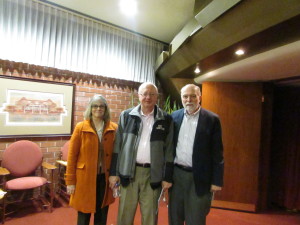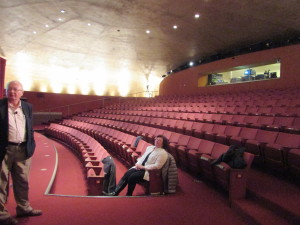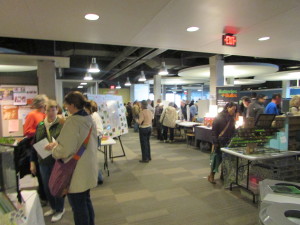How often do any of us look around our communities closely enough to fully understand the extent of the greening activity that is taking place? My guess would be that the vast majority of us—and I include myself—have no idea of the sheer volume of hours and effort that is expended, particularly on a volunteer basis, to keep our cities green and healthy.
I had the opportunity this weekend to get a glimpse of all that effort in a city of about 80,000 just an hour and a half north of Chicago, in Racine, Wisconsin, a lakefront community about 20 miles south of Milwaukee. The gift to me was an invitation from David Rhoads to be the featured guest speaker for an event on Friday evening, March 18, which set the stage for an Eco-Fest the following day at Gateway Technical College. The evening event took place at the SC Johnson Golden Rondelle Theater, a building with a flying saucer appearance on the grounds of the SC Johnson Co. in downtown Racine. I should note that this company has for years sponsored environmental programs in and around Racine and provided backing through its Johnson Foundation for the famous Wingspread conference center, often used for important policy discussions related to environmental and resilience issues.
My theme was “Green and Healthy: The Future of Cities,” but I did not speak about Racine because, frankly, I did not know nearly enough about it, but also because my mission was to introduce the audience to the wider range of urban forestry and green energy activities around the nation. In the bargain, I discussed the role of hazard mitigation and disaster recovery planning in creating resilient communities that minimize the waste of destruction from natural hazards, concluding with the examples of Joplin, Missouri, which included major reforestation efforts in its recovery from a major 2011 tornado, and Greensburg, Kansas, which engineered a green recovery that has made the town 100 percent reliant on renewable energy. In short, my mission was to paint a holistic impression of what it takes to create green and healthy communities.
But David does know very well what has been happening in Racine, which was one reason he was introducing me that evening. We have known each other for nearly 25 years since he was a professor of New Testament at the Lutheran School of Theology in Chicago, and I was chairing the Environmental Concerns Working Group for the Metro Chicago Synod of the Evangelical Lutheran Church in America. David has always been intensely interested in the theology of creation and environmental stewardship. The Working Group mission became, and remains, financing and enabling energy efficiency and renewable energy retrofits for Lutheran churches in the synod, which covers four counties and roughly 200 congregations. David and his wife, Sandy, also a pastor, have made Racine their home and are actively engaged in environmental activism on the local scene, including faith-based environmental awareness efforts. I was thus more than pleased to honor David’s invitation.
Because the intent of my own presentation was to “set the table,” in David’s words, for discussing the greening of Racine, I was followed by a panel of four local professionals: Julie Kinzleman of the Racine City Health Department, who spoke on healthy beaches and water supply; Nan Calvert, on environmental education centers in the area; Matt Koepnick, on urban forestry; and the Rev. Bill Thompkins, an African-American church leader, on neighborhood beautification. Without detracting from the other three in any way, I must say I was particularly taken by Thompkins’s approach. After stating that his inner-city church had asked the question “you don’t necessarily want to ask,” namely, what would happen if your church were no longer present in the neighborhood, he and his parishioners and neighbors undertook to reclaim a city park that had become a gang battleground and began to distribute and plant thousands of plants and trees. What difference does that make? As Thompkins explained, people are more likely to treasure an attractive neighborhood than a neglected one, and to begin to take responsibility for their local environment. Greening the neighborhood, in effect, was a way of restoring the social health of the people in the neighborhood. That echoed a theme I had introduced earlier, citing our APA work in Planning the Urban Forest, that trees have actual mental health benefits that have been documented in social scientific studies. A city that is green is also a city that is healthy for its people.
But what also struck me was the diversity of the efforts underway, including not one but several environmental education centers in the area, and an ongoing expansion of tree-planting efforts in Racine. David asked me for a one-minute closing observation on the program, and that was the one point I chose to make. Look around. See how much is going on around you that you did not know was happening.
The entire program set the stage for a much better attended event the following morning at Gateway Technical College, a school on the lakefront that provides training in environmental technologies. Eco-Fest Racine featured more than 50 displays by groups large and small, activist and educational, including children’s activities, which attracted the immediate interest of my wife, a retired elementary school teacher. Display topics ranged from garbage disposal to recycling to energy audits to urban gardening and forestry to environmental education and advocacy. It included secular groups and Racine Green Congregations, where a woman named Margie informed me ruefully that Wisconsin, under Gov. Scott Walker, an ideological conservative, has been losing its best scientists from agencies like the Department of Natural Resources because of anti-scientific bias from the administration. In the space of just a few hours, neither my wife nor I could absorb all that was offered in this cornucopia of information, but I came to realize one thing: Such events serve a critical purpose in exposing all of us to the breadth of activity that is present in our communities. I do not think Racine is unique, though it is blessed. I think other communities might contemplate the model of this program, the first of its kind in Racine, according to David, as a way of connecting people. We need to be more aware of the ways in which we support each other so that those at work improving their communities can feel less alone. Networking, after all, is an important form of empowerment.
Jim Schwab



